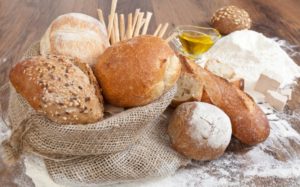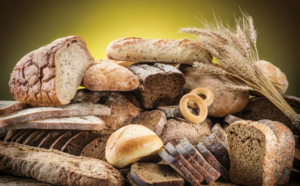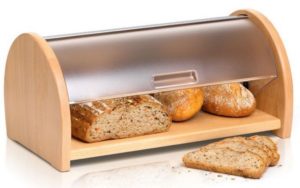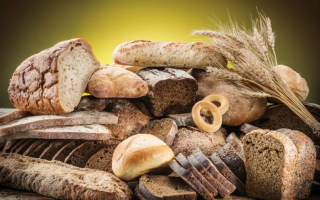Content
- 1 What is bread made of
- 2 How many calories are in a piece of bread
- 3 Types of bread
- 4 The chemical composition and benefits of bread
- 5 The benefits and harms of white (wheat) bread
- 6 Which bread is healthier: regular or whole grain
- 7 At what age can bread be given to children
- 8 What bread can be used for weight loss
- 9 How much bread can you eat per day
- 10 Why eating fresh bread is not recommended
- 11 The healthiest bread recipe
- 12 Is bread harmful
- 13 How to choose bread when buying
- 14 How to store bread correctly
- 15 Conclusion
It would hardly be an exaggeration to say that bread is one of the most popular foods, without which any meal rarely goes. People have been eating it for centuries, considering it useful, but over time, the composition and cooking technology have changed significantly. And today the benefits and harms of bread have become the subject of controversy among nutritionists.
What is bread made of

Baking in stores is quite cheap, so it is considered simple, and therefore natural and healthy. However, this is not quite true.
The composition and properties of the ingredients from which bread is prepared in modern enterprises are rather complex. The recipe includes:
- refined (processed with chemicals) flour;
- various harmful flavors (dyes and improvers, flavorings);
- gluten;
- various types of trans fats and vegetable oils;
- yeast and salt.
Judging by the composition, which is not at all so simple, bread cannot be considered completely natural food, which means there are reasons to consider it harmful to the body.
Refining is a cleaning process in which all the most useful and necessary components for the human body are removed from the grain, only harmful starch remains.
The flour purified in this way no longer contains any useful properties: neither grain germ, a source of vitamin E, nor bran, the main supplier of fiber, nor the aleurone layer of grain, rich in valuable proteins. The harmful properties of trans fats on the human body have long been known, and when baked, vegetable oils form substances with carcinogenic properties.
How many calories are in a piece of bread
Contrary to popular belief, there is not much difference in calorie content between different varieties.
For example, in 100 grams of wheat bread there are from 230 to 250 kcal, and in the same amount of rye bread - about 180 kcal. In order to determine the number of calories in one piece, you need to find out what its weight is. The easiest way to do this is by weighing it on a kitchen scale, but if they are not there, you can use simple calculations.
The weight of an ordinary loaf is on average 600 grams, and if you cut it into 10 pieces, each will weigh 60 grams, and if by 20, you will get a piece weighing 30 grams. That is, if we are talking about white, then there will be 75 or 150 kcal in one piece, depending on how many parts the loaf is cut into. For rye or Borodinsky, this will already be 54 and 108 kcal, respectively.
Types of bread
Today's assortment of bakery products is quite large, but several main types can be distinguished:
- rye;
- wheat;
- rye-wheat;
- wheat-rye.
The rye bread recipe contains seeded rye, peeled or wallpaper flour, and it can be simple and improved. In the second case, malt, molasses, caraway seeds and other components are added to the baking composition. This type has more useful properties.

Simple, improved and rich bread is baked from wheat. For the latter, dairy, eggs and margarine are added to the recipe, making it less useful.
The chemical composition and benefits of bread
According to GOST, a white loaf is baked from wheat flour, vegetable oil, sugar, salt, water and yeast, which make it lush, but more harmful for the figure. It contains in 100 g:
- 7.9% proteins;
- 1% fat;
- 37.7% water;
- 47% dextrins and starch.
This species is the most nutritious and has practically no useful properties.
The gray contains both rye and wheat flour, here is its composition per hundred grams of the product:
- proteins - 8.1 g;
- fats - 3.4 g;
- carbohydrates - 42.2 g.
The beneficial properties of amino acids and radicals improve digestion and strengthen the immune system.
Bran bread has a similar composition to white bread, but bran is added to it, making it a healthy food product. It contains beneficial vitamins and minerals, fiber, zinc, iron, potassium and magnesium, which have a positive effect on the digestive system and brain activity.
Whole grain baked goods are full of vitamins and minerals. It is a source of energy and is beneficial for proper metabolism.
Its composition:
- carbohydrates - 52 g;
- proteins - 8 g;
- fats - 4 g.
Caloric content - from 250 to 300 kcal per 100 g of product.
The benefits and harms of white (wheat) bread
Our ancestors rarely ate white bread; they baked buns only on major holidays.
Scientists have long debated the harmful and beneficial properties of white baked goods, but they all agree on one thing: wheat bread has the lowest fiber content. But coarse fibers are very useful for the normal functioning of the intestines, in addition, they absorb fluid, which allows a person to get enough, with less food.
Thus, the beneficial properties of a wheat product for humans are less than the harm from the starch it contains.
Which bread is healthier: regular or whole grain
Wanting to get more benefits from bread, it is advisable to buy one that is baked from wholemeal flour. The embryos and shells of the grain are preserved in it, therefore this type is called whole grain and it gives more benefits to the body.
These loaves contain fiber, vitamins, minerals and a lot of coarse fiber, which are beneficial for intestinal motility.
But with all the benefits of this type of bread, it is undesirable to eat it for people with adhesions in the intestines and suffering from chronic diseases. Such baked goods can harm the gastrointestinal tract during an exacerbation.
At what age can bread be given to children
Pediatricians advise to introduce baked goods into the child's diet no earlier than from the age of seven months. And it should be crackers. If the child already has teeth, then it is quite possible to give them to him. For a one-year-old toddler, the daily allowance is approximately 50 grams of wheat and 15 grams of black.
For children under one year old, wheat bread of the highest grade is useful, later you can start giving rye. Varieties with the addition of bran are allowed to be given to children from the age of two, when babies are already able to digest cereals.
What bread can be used for weight loss
Often people, wanting to get rid of excess weight, completely abandon baking, endowing it with only harmful properties. However, this is wrong, because it contains the necessary substances.
Whole grain bread has the most beneficial properties, as it contains coarse fibers that benefit the intestines. Dieters often feel hungry, and whole grains can help you fill up faster, without unnecessary calories or harming your figure.

How much bread can you eat per day
Nutritionists believe that black and white bread bring about the same benefits to humans. If there are no contraindications, you can eat up to 300 grams of bread a day without harming your health.
Recent research by scientists has proven that the process of digesting bread depends on the genetic characteristics of each person. Therefore, someone assimilates brown bread better, and someone - wheat.
Men engaged in heavy physical labor can eat up to 500 grams per day, and for older people it is desirable to reduce its consumption to 150 grams.
Why eating fresh bread is not recommended
The fresher and softer the baked goods, the more harm to the stomach, because the composition contains synthetic yeast. Once in the body, they tend to have a depressing effect on the intestinal microflora, disrupting its work. A person feels heaviness and discomfort, bitterness in the mouth. The starch in fresh bread is harmful and irritates the intestinal walls, causing pain and cramps.
That is why it is harmful to eat fresh bread for people who have problems with the liver, stomach and heart. Before using it, it is better to dry it or eat yesterday's bread.
The healthiest bread recipe
Of course, home-baked bread will be the most useful, because there will be only known ingredients and no food additives.
Here is one recipe for cooking without yeast:
- natural mineral water - 500 ml;
- 500 - 600 g whole grain rye flour;
- salt - 3 g.
Mix dry ingredients, knead the dough, gradually adding warm mineral water. Give the dough any desired shape, make several transverse cuts on it and bake in a preheated oven for at least an hour.
Of course, not everyone has the opportunity and time to bake bread on their own, but the benefits from it will be much greater than from the one bought in the store.
Is bread harmful

In order to bake a loaf, a minimum set of products is needed, however, manufacturers, in order to give the product a more attractive presentation, add flavoring additives, improvers and flavorings with harmful properties to the composition.
In addition, most of all bread sold is baked from refined flour, which is almost completely useless. It also often contains malt and molasses, which are chemical by-products of sugar production.
How to choose bread when buying
To date, there is no law obliging manufacturers to prescribe on the packaging the full composition of its ingredients, including those that are harmful to health. Therefore, it is quite difficult for customers in the store to choose bread that will benefit the body, not harm.
But still, choosing a loaf in a supermarket, you should focus not on its freshness and splendor, but on the label and the products indicated on it. Preference should be given to a product baked from whole grain, wallpaper, peeled flour, with the addition of bran.
It is better that the composition does not contain flavors and flour improvers. In addition, yeast-free bread has more beneficial properties for the body.
How to store bread correctly

Traditionally, the place for storing pastries is the bread bin. It can be made of plastic, metal or wood. The breadbox should be washed periodically, and if it is wooden, then after washing, before putting a loaf in it, it must be thoroughly dried.
In addition, wheat loaf and baked goods must be stored separately from rye bread: this way they will keep their freshness and healthiness longer.
If longer storage is required, then you can use the freezer, only in this case, the loaf or long loaf must first be cut in order to defrost the required amount, and not the whole loaf. With this method, the shelf life and useful properties of bread can be extended to several months.
A stale loaf can be freshened up by holding it in a water bath or in the oven, after sprinkling with water.
Conclusion
The benefits and harms of bread depend on its competent use:
following a number of simple rules, you can eat pastries without fear of harming your health:
- you should not eat fresh or hot bread;
- keep different varieties separate from each other;
- a moldy loaf acquires harmful properties: it cannot be cut off from mold for further use;
- any bread goes best with animal products;
- the fewer the ingredients in the baked goods, the more useful it is.
Which bread to give preference, everyone decides for himself. Someone likes lush buns, while others eat only yeast-free rye bread. It all depends on taste preferences and state of health, because there are medical contraindications for the use of some varieties.
See also:

